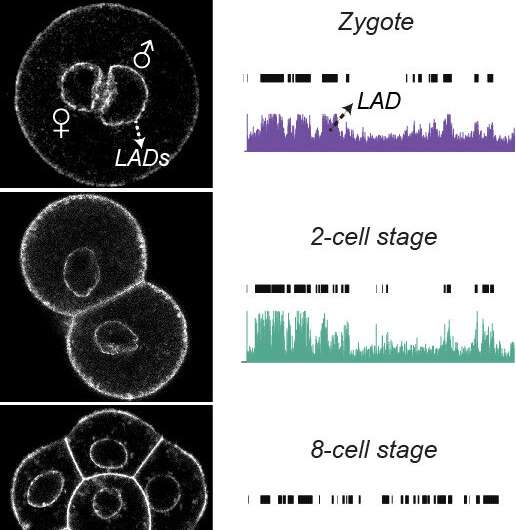Spatial DNA organization forms first, then the rest

The fundamental organization of the DNA in active and inactive compartments arises immediately after fertilization of the oocyte, even before genes are activated. This was discovered by researchers from the Hubrecht Institute and the Helmholtz Center Munich and will lead to a better understanding of the mechanisms behind the development of a single fertilized oocyte into a complete organism that consists of many different cell types. The results were published in the scientific journal Nature on the 22nd of May.
A fertilized oocyte, a zygote, eventually develops into a whole organism that consists of trillions of cells with a wide diversity of functions. Despite these various functions, the DNA in all of these cells is the same. The identity of cells is determined by sets of genes that are turned "on" and "off." But how do all of these cells organize which genes are turned "on" and which are turned "off"?
DNA organization in the nucleus
The DNA is not just haphazardly deposited into the nucleus of the cell, but instead spatially organized in active and inactive compartments. The compartments that are not active are tethered to the edge of the round shaped nucleus. This edge consists of a thin layer that is called the lamina, and these DNA compartments are therefore called Lamina Associated Domains, or LADs.
"You can compare the DNA that is divided into LADs and inter-LADs to a very long garland, that is not tangled up on the floor of the living room, but instead attached to the ceiling at anchor points," says Jop Kind, group leader at the Hubrecht Institute. "This results in a spatially organized chromosome-partitioning that makes the untethered parts (the inter-LADs) more accessible for activation compared to the parts that are tethered to the ceiling (the LADs)." In cells with different functions, different parts of the DNA are tethered to the lamina, although there are certain LADs that are present in all cell types.
New method
Different cell types thus differ in the sets of genes that are turned 'on' and 'off' and which parts of the DNA are tethered to the lamina. Until now, it was unclear which of these characteristics occurs first in the cell.
.
The researchers therefore developed a new method through which they could analyze the organization of the DNA in LADs and inter-LADs very early in the development of an embryo. They did this at different timepoints, from the early zygote, even before genes are activated in the embryo, until the moment at which the embryo consists of eight cells.
Which characteristic forms first?
The researchers discovered that the DNA in the zygote is already organized in LADs and inter-LADs before genes are activated in the embryo. LADs are therefore formed before the activity of genes starts to play a role.
In addition, the researchers found that the activity of genes during the development of an embryo changes in accordance with changes in the LAD structure. Therefore, it seems that organizing the DNA into LADs and inter-LADs is a very early event in a process that eventually leads to the identity of a cell.
Primitive LADs
The LADs that were found in the early zygote turned out to very closely match the LADs that are present in all cell types. In addition, these LADs match the LADs in the so-called pluripotent stem cells, those that can still develop into all cell types of the embryo. "The LADs in the zygote therefore seem to be 'primitive' LADs," says Kind, "some sort of basic suspension system in the cell nucleus that can be built upon when the cell specializes."
The newly developed method and its first results show that this approach can be used to further investigate the mechanisms involved in the formation of an entire organism from a single fertilized oocyte. In the future this will lead to a better understanding of normal development, but will also give more insights in what can go wrong during the development of an embryo.
More information: Genome–lamina interactions are established de novo in the early mouse embryo, Nature (2019). DOI: 10.1038/s41586-019-1233-0 , www.nature.com/articles/s41586-019-1233-0
Journal information: Nature
Provided by Hubrecht Institute



















